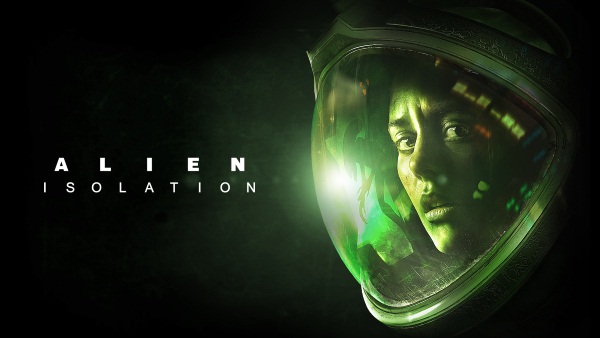
It’s been some time since we’ve seen a developer with a sizeable budget tackle the survival horror gaming genre. Of course, Dead Space and Resident Evil have always had money behind them, but those series lean more on the action side of the spectrum. This isn’t to devalue indie developers or studios that don’t have the financial means that other developers are privileged to have. Instead, it highlights the focus shift that seems to be happening this year in regards to the spooky games we all so cherish. Alien: Isolation is representative of what a team can do when given the money and time to realize their complete vision.
From the second the game boots up to moment the credits rolls, Alien: Isolation is a pitch-perfect homage to the original movie. The 80’s low-tech vision of the future, the grain filter that slightly obscures your vision in the best ways, the constant dissonance of the score penetrated by haunting ambient sounds – all of it brings to mind a team of developers that grew up watching Alien over their parents’ shoulders while clad in their jammies. This adherence to the source material gives the game such a tangible texture that it actually makes you appreciate the movies even more than you thought possible.
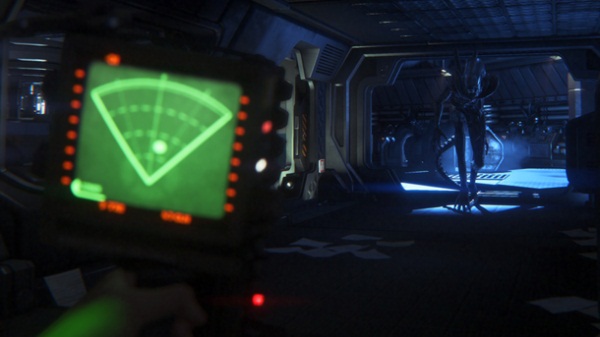
Taking place fifteen years after the first movie, Isolation stars Ellen Ripley’s daughter, Amanda. She’s an engineer employed by Weyland-Yutani, the corporation that was in control of Ellen and her crew’s ship, the Nostromo. When promised by a member of the corporation that the Nostromo’s flight recorder has been recovered, Amanda is convinced to join a crew heading to the Sevastopol space station. When a small part of their group tries to board the Sevastopol, the most prolonged case of Murphy’s law strikes and they are unable to leave the hellish station. Doors, tram stations, androids, even the damn space Roombas are malfunctioning. Oh, and there’s another teeny little problem – something is slithering through the vents and killing the few people that have survived thus far.
These opening hours are among the most effective, because Isolation is a masterwork at least as far as pacing goes. Whereas most games are content to shock you with a setpiece as soon as they can, it takes a loooooong time before the titular Alien becomes a regular fixture in your traversal through the station. While this could have been a problem in a shorter game, Isolation lasts north of 15 hours and it just feels right. Since you’re constantly traveling to new areas and finding new ways to distract the threats on the station, it rarely feels like you’re wasting your time. There is some backtracking (I’m biased here, as I enjoy backtracking in most games) but it only serves to make the Sevastopol feel like a more fully realized, lived-in space.
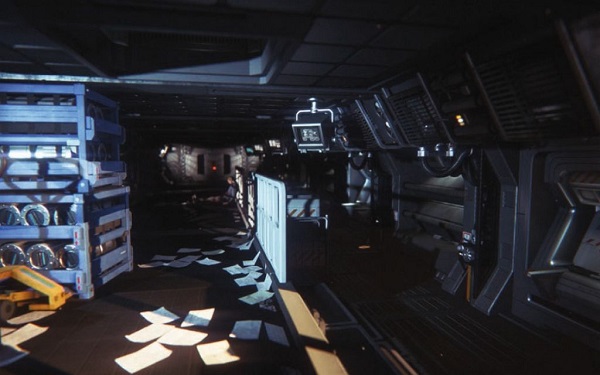
The Alien him/her/itself has been a point of much contention since the release of the game. Is the AI fair, or is it cheating and warping around you? Does it really learn from the player’s behavior? How am I supposed to have fun if it just keeps killing me? Well, the verdict is … it’s hard to say. Since it spends the majority of its time crawling through invisible vents and popping out at the perfect SHIT moment, it’s difficult to gauge whether it is playing fair. On the other hand, the game didn’t feel all that difficult on the normal difficulty for me, mostly due to a couple of things: 1) Once you get the the flamethrower about halfway through, three quick bursts are enough to send Xenny running, and 2) the crafting system is hugely generous, especially when you know a couple of tricks that aren’t immediately apparent.
The crafting system that some people were dreading when Isolation was announced ends up being a huge boon for Amanda’s survival. You won’t be crafting bazookas (though you will eventually have a few guns to use against the human and android enemies). Instead, almost everything you can build out of the components laying around the station is a distraction that will help you eke out a few precious seconds and a chance to escape. These items, especially the emp mine and noisemaker, are so useful that you’d think they would be very few and far in between. Maybe I was just using them to sparingly, but I was almost always fully stocked, which brings me back to the trick that I mentioned previously. Though you can usually only carry three of each item, you can also hold a certain amount of components for building these tools. After just a few levels, you’ll find that you can’t pick anything else up because your inventory is full. But if you allocate these bits n’ bobs to the tools even if you are fully stocked, they open up space in your inventory. Once you realize this, you’ll be tossing pipe bombs like a madwoman, which removes many of the threats you will encounter.
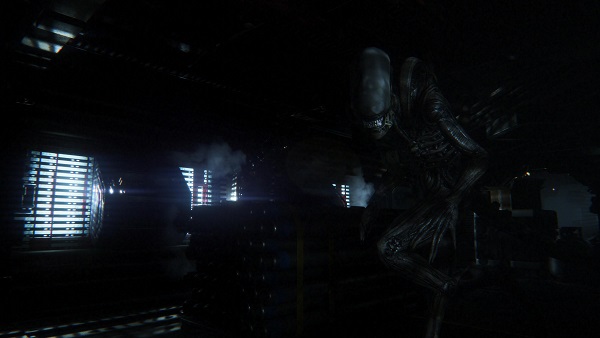
In fact, the abundance of components around the Sevastopol combined with the flamethrower serves to remove much of the fear in the second half of the game. Knowing that you can ward off the Alien if it gets too close gives you a little too much courage compared to the opening hours. And while the Working Joe androids are aesthetically terrifying with their blank faces and neutral-yet-ominous sort-of threats, they are easily downed with a stun prod and a few wrench smacks. Before receiving the flamethrower, I was loving every encounter with the Xenomorph. Slowly creeping down halls, crouching behind gurneys, and using my motion tracker in a frantic paranoia led to some deliciously tense moments. There was one moment where I riskily tried to use a computer terminal to open a door, knowing that I was probably going too slow, when I heard the tell-tale thunk of the Alien landing behind me and hissing. I knew I had screwed up, and the sound froze me into a rigid (probably taller) version of myself. There was nothing I could do, and I closed my eyes and let it happen. That is exactly how it should be. If the Alien is that close, you’re done. While it makes sense that the flamethrower should give you a defensive chance, and that other movies in the series led to more vulnerable Xenomorphs, I can’t help but feel that this option diminishes the consequences of the Alien’s presence a hair too much.
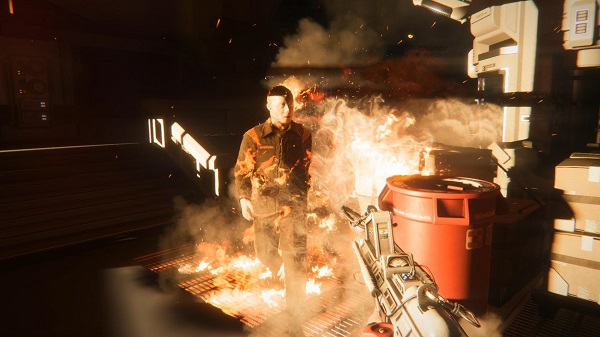
Which is why I am so glad that Alien: Isolation decided to go with manual save points. Peppered throughout the Sevastopol are emergency kiosks for you to save your game. They take a few seconds to activate; you have to listen to the beep….beep….beep before the game prompts you to save. Even when I was armed with the flamethrower, these moments were anxiety-ridden in the best way. Would I have enough time to save? Was the Alien just a room away? CAN I HEAR IT RIGHT NOW? If you make the mistake of saving with the Alien right next to you, you can always return to your previous save. These kiosks always seem just the right distance away from each other, where you’re nervous about getting too far away from one but know that there will most likely be one a room over if you can…just…go a little…oh, you’re dead again. I often had to repeat small sections, but again, the distance between these never made the repetition unbearable. There was one annoying problem (feature? bug?) where upon reloading after a death, I would have to listen to the same audiolog that I was listening to every time I died. In the few sections death was more common, this quickly wore thin. I imagine it was there so that you would receive a quick recap when resuming the game after awhile, but it should repeat over and over when you die multiple times in one play session. Still, Creative Assembly deserves praise for having the guts to utilize a manual save system in a AAA horror game. It’s sure to upset some people, but the punishing ramifications of not being able to just revive right around the corner are completely worth it.
When you aren’t being hounded by the Alien, it’s impossible not to be swept up in the atmospheric visuals and sound that Creative Assembly have perfected here. Sevastopol would have been an engaging environment even if there were no threats to be found there. As Alien is iconic and is the originator of so much what we see in sci-fi videogames, it almost feels like homecoming of sorts to see this retro-futuristic aesthetic in an actualized space. The Sevastopol has one of the most tonally consistent worlds I’ve ever had the pleasure of experienced. Every sound effect from the satisfying clickety-clack of the computer keyboards to the gurgling death rattle of the androids feels perfectly picked. And in the rare moments that you can watch the Alien hunt you and not get killed for being careless, it’s wonderful watching how convincingly its been animated. No matter how many times you’re hiding under a desk and watching its tail slide by you, it’s hard not to appreciate the love that’s been poured into crafting something so hideous. It’s a shame then, that the humans look like wooden puppets and their mouths are rarely synced up to what they are saying. While you spend most of your time alone, the few times that you interact with other people served to distance me from the experience somewhat. The pre-rendered cutscenes would be better in this regard if they weren’t so choppy, often sporting a sub-20 framerate, at least on PS4. When the environment is this convincing and the Alien is perfectly realized, it’s easy to see where the money went.
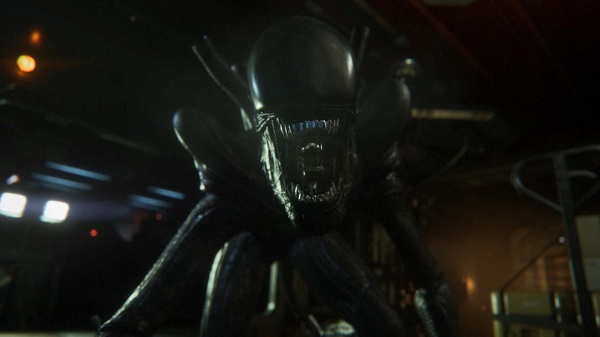
If you know anything about the movie franchise, you know how Amanda Ripley’s journey ends. While some were apprehensive about this game being shoehorned into the canon, it fits just fine. The story that’s being told here isn’t hugely interesting, but Amanda’s voice acting works well enough to make you empathize for the loss of her mother. The other characters present in the game aren’t very memorable and mostly serve to get you from point A to point B. I was hoping there would be some sort of twist that changed our perspective on the series somewhat, but the plot is fairly straight-forward. It’s not offensive in anyway, it just feels as though more creative liberties could have been taken.
Despite these few missteps, Alien: Isolation shows why big-budget horror still has a place in today’s gaming industry. Is it challenging in parts? Sure (especially the first encounter with humans. Ugh!) But the game provides more than enough tools to help you make your way through Amanda’s nightmare. Top-notch environmental storytelling, some of the best audio design in recent memory, and harrowing encounter after harrowing encounter with the various threats of the Sevastopol all end up coalescing into a game finally worthy of the Alien franchise. Remember, there’s always easy mode! This one isn’t to be missed. And make sure you wear headphones.
 (9 / 10)
(9 / 10)
Amazing
 (9 / 10)
(9 / 10)
 ZackFurniss
ZackFurniss


